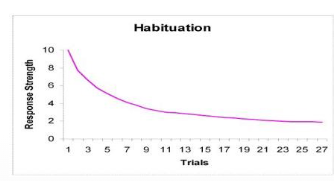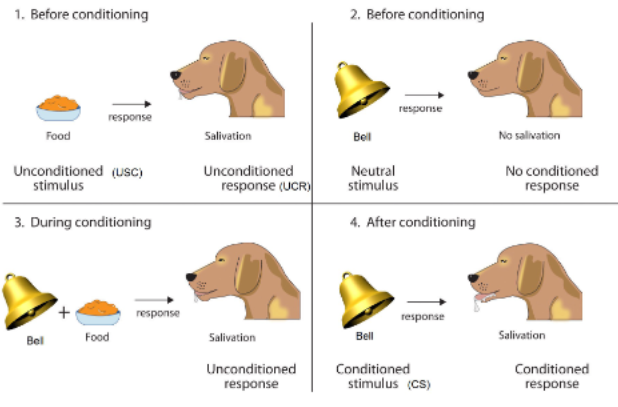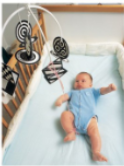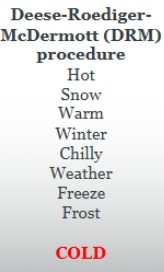Learning, Memory, and Metacognition
1/38
Earn XP
Description and Tags
Week 7; PSYC 2007
Name | Mastery | Learn | Test | Matching | Spaced |
|---|
No study sessions yet.
39 Terms
What is learning?
A fairly permanent change in behaviour due to past
experience.
The relationship between experience and behaviour.
Reflexes are innate responses that don’t need to be learnt.
Learning allows us to adapt to our environment.

Habituation
Response to a stimulus declines with repeated
presentations of that stimulus
Develops very early on
Highly adaptive
Diminished attention to “old” stimuli allows infants to pay
attention and learn about new stimuli.
(Dirix, Nijhuis, Jongsma, & Hornstra, 2009)
Foetuses show habituation to a vibroacoustic stimulus as early as 30 weeks’ gestational age.

Pavlovian (Classical) Conditioning
Unconditioned stimulus (UCS)- A stimulus that elicits a reflexive response
Unconditioned response (UCR)- The reflexive response
physiological
emotional
Conditioned stimulus (CS)- A neutral stimulus which will later elicit desired response
Conditioned response- The response to the pairing of CS and UCS
2 processes- Acquisition + Extinction
Acquisition
Extinction
Classical Conditioning in infants
Association between mother + comfort, security and warmth
Learning to feed – UCS = breast, UCR = sucking, CS = breast/bottle, CR = sucking
In newborns = limited to biologically programmed reflexes.
Lipsitt & Kaye (1964): Classical Conditioning Infants
Neutral tone paired with a breast→ 2-3 day old infants made sucking motions at the sound of the tone/before breast was presented.
When do Infants show exinction? - (Blass, Ganchrow, & Steiner, 1984)- Classical Conditioning Infants
As young as 2-24 hours old.
Evaluative conditioning
In older children and adults- classical conditioning can affect preferences.
Field (2006)- (9-11 year olds)
Fear Conditioning- (Watson & Rayner, 1920)
Little Albert Experiment – 9 month baby
At firsts: well adjusted. No fear for a wide range of objects
Watson smashed a big steel bar down behind his head which made a horrible noise/ Albert was scared
• Noise paired with a white rat 7 times
• Fear of white rat/furry objects
Instrumental (Opperant) Conditioning
Relationship between one’s own behaviour and the reward (reinforcer) or punishment it produces.
Reinforcement (Negative/Positive)
Punishment (Negative/Positive)

Reinforcers:
Changes in environment that follow a behaviour and increase the probability that the behaviour will reoccur.
Positive Reinforcement
Bringing good things to the animal/person to increase behaviour.
(e.g., money, praise, food)
Negative Reinforcement
Taking bad things away from the animal/person to increase behaviour.
(e.g. removing pain, toothache, hunger)
Punishments:
Changes in environment that follow a behaviour and decrease the probability that the behaviour will reoccur.
Positive punishment
Presenting an aversive stimulus after a response
(e.g., electric shock to induce pain)
Decrease Behaviour
Negative punishment:
Taking good things away from the animal/person.
(e.g. withdrawal of food or money)
Decrease Behaviour
Studying instrumental conditioning in infants
Sucking
Newborns to obtain a sugar solution (Lipsitt et al., 1966).
5-12 week olds to keep a movie in focus (Kalnins & Bruner 1973).
Head turning
Infants as young as 4 days will turn their head to obtain sucrose water.

Mobile Conjugate Reinforcement Paradigm
Ribbon is connected to a baby’s ankle and a mobile
Infants naturally kick their legs/ learn the
contingency between kicking and the movement of the mobile.
3-month olds remember the kicking-reinforcement relationship up to one week later.
6 month olds - will push a lever to make a train move along a track.
Retention duration increase with age.
Remembering can be reinstated after long delays even in very young infants with reminders of the contingency.
“Spacing Effect” - 2 practice trials spaced apart produces better retention than 2 practice trials close together.
“Misinformation Effect” - exposure to 2nd mobile
reduced the likelihood that the infant would remember the first mobile.
Observational learning
Bandura (1965)
Observational learning and modelling: watching behaviour of others
Mere exposure
Whether behaviour is repeated depends on observed consequences.
Bandura Doll
Imitation
a form of observational learning
(Meltzoff and Moore (1977)- Newborns can imitate
(Oostenbroek et al.,2016)- Disputed
6 months- infants show clear/ complex imitation.
At what age do infants shoe clear/complex imitation?
6 MONTHS
Why is measuring infant memory difficult?
Infants cannot give verbal responses until 1 yr
Early childhood is a time of rapid cognitive growth, but different systems grow at different paces
Researchers must rely on innovative methods
(Kisilevsky et al., 2003)- auditory recognition
Foetuses recognise their mother’s voice one-two
weeks before birth.
Visual Recognition
Infants show novelty preference- they prefer to look at new things.
Infants can be presented with a novel stimulus,
which is later hidden.
When the stimulus is presented, reduced looking is indicative of recognition memory.
Visual paired comparison task- (Fantz, 1964)
Used across the entire period of infancy
Doesn’t require motor skills
(Pascalis & de Schonen, 1994)- response seen at 3 days old; 2- minute retention interval.
Time needed to familiarise with the original stimulus decreases with age (stimulus encoding gets faster).
Retention over longer interval (days to months) increases with age → internal representation of stimulus is viable for longer.
2 theories as to why memory improves during early childhood:
Memory efficiency
Memory strategies
Memory Efficiency
Memory processes improve with age
(i.e. working memory capacity increases, learning becomes more efficient)
(Kail, 1991)- Digit span increases from two (2-yr olds) to six (9-yr olds)
Memory Strategies:
Children learn effective memory strategies as they get older.
(e.g.,elaboration, rehearsal, organisation)
Children as young as 18 months- verbally rehearse the location of a hidden object more than a visible object (De Loache et al., 1985)
Young children (age 3-6) do not spontaneously use elaborative encoding; older children (7-8) do.
Episodic memory
Infantile amnesia- Adults don’t remeber events from 1st 3 years of life/ few from next 2(i.e 1-5 years)
Young children forget episodic memories as they age.
Not uniquely human (seen in rats)
Unknown Cause
May be due to development of crucial learning/memory brain regions (i.e hippocampus).
14-15 years: As memory becomes adult-like, working memory capacity increases, and children integrate meaning into episodic memory.
(Holliday, Reyna, and Brainerd,2008).
Incorporating meaning leads to a richer memory trace.
Can make older children more susceptible to memory illusions.

Deese-Roediger-McDermott (DRM) Procedure
Theory of Mind
Awareness that other people have different states of awareness to you.
Metacognition
Understanding of our own minds.
Metamemory
Our knowledge and awareness of own memory processes
Metacognition Development
5 yrs- children know which material is easy/difficult to learn
Judgements of Learning (JOLs)- in 1st few yrs of school.
Overconfidence- Children are often overconfident, even with practice.
Shin, Bjorklund, & Beck (2007): OVERCONFIDENCE
Children consistently overestimated the number of pictures they would recall across multiple lists.
Children with higher levels of overconfidence showed greater gains in recall than children with lower levels of overconfidence.
‘Adaptivity’ Hypothesis: overconfidence helps to keep children engaged in difficult activities (Bjorklund & Green, 1992)
Metacognitive control- (Schneider & Löffler, 2016)
Young children use their metacognitive knowledge to influence their learning.
7-8 yrs- children will choose to restudy items that they gave lower JOLs more often than items to which they gave high JOLs